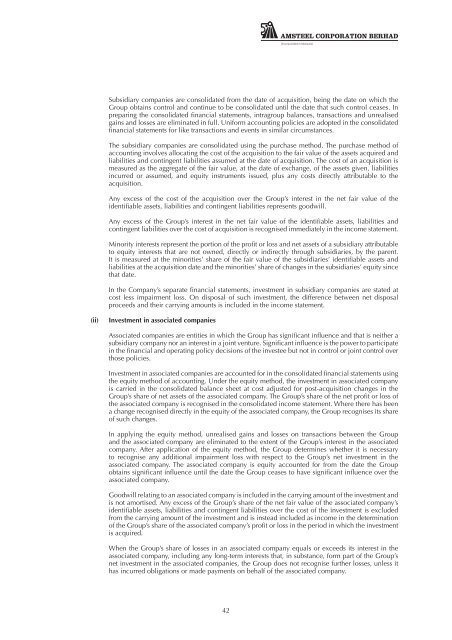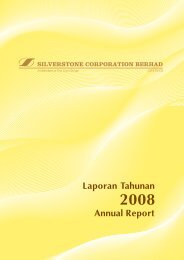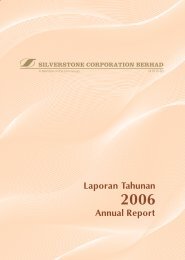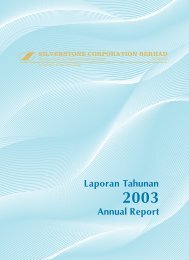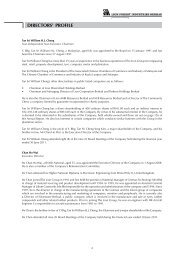Annual Report 2007 - The Lion Group
Annual Report 2007 - The Lion Group
Annual Report 2007 - The Lion Group
Create successful ePaper yourself
Turn your PDF publications into a flip-book with our unique Google optimized e-Paper software.
AMSTEEL CORPORATION BERHAD<br />
(Incorporated in Malaysia)<br />
Subsidiary companies are consolidated from the date of acquisition, being the date on which the<br />
<strong>Group</strong> obtains control and continue to be consolidated until the date that such control ceases. In<br />
preparing the consolidated financial statements, intragroup balances, transactions and unrealised<br />
gains and losses are eliminated in full. Uniform accounting policies are adopted in the consolidated<br />
financial statements for like transactions and events in similar circumstances.<br />
<strong>The</strong> subsidiary companies are consolidated using the purchase method. <strong>The</strong> purchase method of<br />
accounting involves allocating the cost of the acquisition to the fair value of the assets acquired and<br />
liabilities and contingent liabilities assumed at the date of acquisition. <strong>The</strong> cost of an acquisition is<br />
measured as the aggregate of the fair value, at the date of exchange, of the assets given, liabilities<br />
incurred or assumed, and equity instruments issued, plus any costs directly attributable to the<br />
acquisition.<br />
Any excess of the cost of the acquisition over the <strong>Group</strong>’s interest in the net fair value of the<br />
identifiable assets, liabilities and contingent liabilities represents goodwill.<br />
Any excess of the <strong>Group</strong>’s interest in the net fair value of the identifiable assets, liabilities and<br />
contingent liabilities over the cost of acquisition is recognised immediately in the income statement.<br />
Minority interests represent the portion of the profit or loss and net assets of a subsidiary attributable<br />
to equity interests that are not owned, directly or indirectly through subsidiaries, by the parent.<br />
It is measured at the minorities’ share of the fair value of the subsidiaries’ identifiable assets and<br />
liabilities at the acquisition date and the minorities’ share of changes in the subsidiaries’ equity since<br />
that date.<br />
In the Company’s separate financial statements, investment in subsidiary companies are stated at<br />
cost less impairment loss. On disposal of such investment, the difference between net disposal<br />
proceeds and their carrying amounts is included in the income statement.<br />
(ii)<br />
Investment in associated companies<br />
Associated companies are entities in which the <strong>Group</strong> has significant influence and that is neither a<br />
subsidiary company nor an interest in a joint venture. Significant influence is the power to participate<br />
in the financial and operating policy decisions of the investee but not in control or joint control over<br />
those policies.<br />
Investment in associated companies are accounted for in the consolidated financial statements using<br />
the equity method of accounting. Under the equity method, the investment in associated company<br />
is carried in the consolidated balance sheet at cost adjusted for post-acquisition changes in the<br />
<strong>Group</strong>’s share of net assets of the associated company. <strong>The</strong> <strong>Group</strong>’s share of the net profit or loss of<br />
the associated company is recognised in the consolidated income statement. Where there has been<br />
a change recognised directly in the equity of the associated company, the <strong>Group</strong> recognises its share<br />
of such changes.<br />
In applying the equity method, unrealised gains and losses on transactions between the <strong>Group</strong><br />
and the associated company are eliminated to the extent of the <strong>Group</strong>’s interest in the associated<br />
company. After application of the equity method, the <strong>Group</strong> determines whether it is necessary<br />
to recognise any additional impairment loss with respect to the <strong>Group</strong>’s net investment in the<br />
associated company. <strong>The</strong> associated company is equity accounted for from the date the <strong>Group</strong><br />
obtains significant influence until the date the <strong>Group</strong> ceases to have significant influence over the<br />
associated company.<br />
Goodwill relating to an associated company is included in the carrying amount of the investment and<br />
is not amortised. Any excess of the <strong>Group</strong>’s share of the net fair value of the associated company’s<br />
identifiable assets, liabilities and contingent liabilities over the cost of the investment is excluded<br />
from the carrying amount of the investment and is instead included as income in the determination<br />
of the <strong>Group</strong>’s share of the associated company’s profit or loss in the period in which the investment<br />
is acquired.<br />
When the <strong>Group</strong>’s share of losses in an associated company equals or exceeds its interest in the<br />
associated company, including any long-term interests that, in substance, form part of the <strong>Group</strong>’s<br />
net investment in the associated companies, the <strong>Group</strong> does not recognise further losses, unless it<br />
has incurred obligations or made payments on behalf of the associated company.<br />
42


